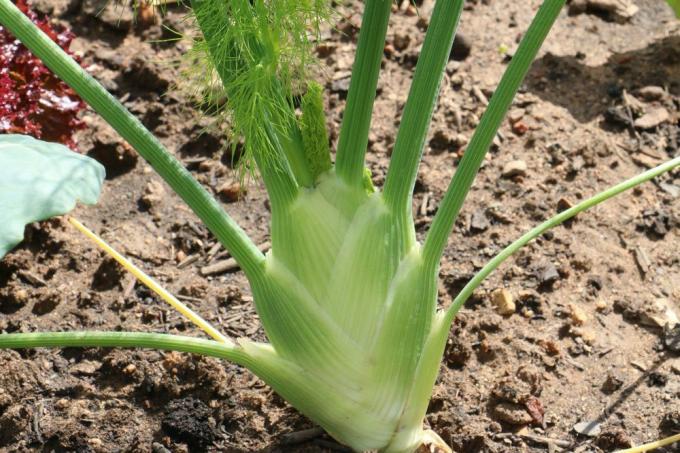
table of contents
- Eat fennel raw
- Eat raw - but right!
- The stalk
- New question - old answer
Whether as a tea, in a stew or as an independent vegetable, fennel is used in many forms in our domestic cuisine. In addition to the taste, the tuber also convinces with numerous healthy ingredients. Raw consumption would therefore be ideal, without changing or even destroying these substances through heat and cooking. But can you actually eat fennel raw? And what about the solid stalk, which according to numerous relevant recipes has to be removed?
Eat fennel raw
It is often believed that it is essential to cook Foeniculum vulgare before eating. Numerous cooks conclude from this that the tasty tuber is even poisonous and must inevitably be heated before eating. But that is clearly not the case. On the contrary. In vegan cuisine, fennel is often used raw due to its delicate yet aromatic taste. Whether as a salad or cut into strips with various dips, it can be consumed uncooked very well and without worry. In contrast to preparation by heating, raw consumption even has the advantage that all of its valuable ingredients are completely retained and benefit the consumer:
- Vitamins A, B and C.
- Essential oils such as myrcene, anethole and fenchone (also decisive for the typical taste)
- Silica
- Folic acid
- Mineral salts
- Trace elements
- Minerals such as calcium, potassium and magnesium
- Vegetable starch
Toxic ingredients, however, are not known. On the contrary. The umbellifer even works through the combination of numerous substances it contains stomach soothing and is considered a light and digestible meal.

tip: Because of its mild aroma, fennel is also very suitable for introducing children to raw vegetables and vegetables in general! Its crunchy, but not too hard consistency is fun to nibble and eat on the side.
Eat raw - but right!
It is a verifiable fact that many people consume Foeniculum vulgare only cooked. The reason is certainly not that the plant is poisonous. Rather, it is more likely that you do not use raw foods Fennel plants The reason for this is that the plant is very sensitive and easily forms pressure points. These tend to rot quickly, the taste of which can radiate into large areas of the tuber. In addition, sand and dirt tend to accumulate between the onion-like layers, which leaves the plant edible, but can easily spoil the enjoyment of enjoyment. Eaten as a raw food, it is therefore advisable to consider the following steps:
- wash very well
- Cut out pressure points
- Alternatively: peel off the whole layer with pressure points facing down
- Check for sand between layers before consumption
- If it is very dirty, loosen layers and wash and prepare separately
- Either brush off the roots thoroughly or remove them
The stalk
Now, however, the question also arises as to how things are with the stem of the plant. If you believe numerous cookbooks, this must be removed before eating. Again, the reason is definitely not the fact that it is poisonous. It is certainly edible, but compared to the rest of the tuber it is much harder and firmer and makes it much more difficult to use. Even if the heart of the tuber could theoretically be eaten raw, it is actually worth cooking and thus softening its substance.
tip: The stems are very similar to the stem area. They are also very woody, but have a much stronger aroma. They too should be cooked before consumption. But they are by no means poisonous even when raw!
New question - old answer
The well-known and highly respected healer Hildegard von Bingen recognized Foeniculum Vulgare as one of the few 100 percent healthy universal remedies. She said that regardless of how it was consumed, fennel is able to make people happy. It is also suitable for warming up, stimulating sweating and promoting blood circulation. Hildegard von Bingen also attributes disinfecting effects to fennel and its seeds and an improvement in the human breath.
From the formulation she uses “however it is eaten” for the type of consumption infer that heating or even boiling around 1000 years ago was not considered to be absolutely necessary became. At the same time, von Bingen does not limit the enjoyment in any way, so that this should also be sufficient evidence that nothing poisonous about fennel is. Basically harmless are therefore:
- root
- tuber
- stalk
- Stems
- leaves
- Seeds

tip: Today, fennel seeds can often be found on the spice shelves as an independent component of the plant. They are used to flavor dishes and are suitable for both raw and cooked dishes.
